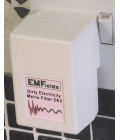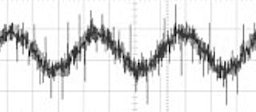Dirty electricity (DE), also known as dirty mains, dirty power, or electrical pollution, is a term that describes the problem of electromagnetic noise on the mains wiring of a house. DE occupies a part of the spectrum in-between the power frequency fields created by powerlines and substations, and the microwaves produced by mobile phone masts and other wireless devices.
Dirty Electricity can travel into your house on the local electricity supply and it will also be generated by some devices in your home. In the UK, the incoming supply is normally quite clean so the majority of DE is generated by internal devices, though large blocks of flats and similar multi-occupancy living spaces can have a lot of shared DE sources. Common large DE contributors include induction cooker hobs, dimmer switches, televisions, fluorescent light bulbs (including CFLs, or energy efficient bulbs) and computers. Any modern device that has a "switched mode power supply" will create some DE. Solar panel inverters that generate the 230 volts to feed into the electricity supply usually generate a large quantity of dirty electricity.
Many links have been published associating Dirty Electricity with a wide variety of negative health effects, including cancer, asthma, chronic fatigue syndrome, diabetes, ADD, autism and a number of neurological disorders.
 |
How to reduce DE with filtersYou should first try to work out what is causing the DE on your wiring, to determine the best way to reduce/remove it. The EMFields DE filters will reduce the level of DE when plugged in to the same circuit that you've tested the levels in. To use the DE filter, you simply plug it in and switch it on - ideally as close as possible to the item that is causing the DE. For DE coming into the home from solar panels or from the incoming electricity supply, it is important to place the filters as close as possible to the consumer unit (fusebox) and electricity meter. It is very important to suppress the DE as close as possible to its source or it will flow backwards and forwards on the house wiring between the source device and the DE2 filter(s). You may decide to replace some devices with similar ones that produce less DE. Low energy CFL lamps are a good example - some produce lots of DE and some relatively little. Generally LED lamps produce less DE, though incandescent lamps produce virtually none and many electrically sensitive people need to only use incandescent bulbs - "rough service" incandescent bulbs up to 100W are still legally available in some shops (not supermarkets!) and via the internet. Similarly, some dimmer switches produces masses of switching noise and some relatively little - but if you are ES then simple switches are better as they do not produce DE. |
What is Dirty Electricity?
Dirty electricity (DE), also known as dirty mains, dirty power, or electrical pollution, is a term that describes the problem of electromagnetic noise being on the mains wiring of a house, when it isn't supposed to be. Basically, your electrical supply is supposed to have just a 50 Hz sine wave on it, but this is rarely the case. There are almost always significant 2nd and 3rd harmonics (100 and 150 Hz in Europe, 120 and 180 Hz in USA), but these are not thought to be any more harmful than the pure sine wave.
DE consists of high frequency "electrical noise" of 1000 Hz (1 kHz) and upwards that has become superimposed on your wires. It is mostly from devices with "switched-mode power supplies", but includes short sharp transient spikes from inductive loads like motors being switched on and off. Most of the published work on this uses the Stetzer Microsurge meter which measures noise between about 2 kHz and 120 kHz, however the DE noise extends up into the MHz region.
Dirty Electricity can travel into your house on the local electricity supply, or it can be generated by devices in your home. In the UK, the incoming supply is normally quite clean, so the majority of DE is generated by internal devices, though large blocks of flats and similar multi-occupancy living spaces can have a lot of shared DE sources.
dLAN network adapters also put RF signals on your mains wiring and it is good to switch them off at night. The levels in the house rooms are vanishingly tiny when compared with wLAN / WiFi signals, however they may still affect electrosensitive people. dLANs use radio-frequencies above 150 kHz that go up to several tens of megahertz (MHz) and are carried equally on all the wires. These are are not detected by Dirty Electricity meters. High speed/bandwidth (500 Mbps and faster) dLANs produce electrical RF noise up into the 100s of MHz.
Common large contributors to DE include solar panel inverters, induction cooker hobs, dimmer switches, televisions, fluorescent light bulbs (including CFLs, or energy efficient bulbs) and computers. Any device that has a "switched mode power supply" will naturally create DE, but it's hard to tell exactly which devices do have them and which ones don't without switching them on and off. Most modern, energy efficient, electronic devices now have them. Older, non-electronic devices such as lamps, ovens, or devices that run on motors, don't normally create much DE.
We must note that whilst large amounts of DE noise is undoubtedly placed on the mains cable, the electromagnetic fields it causes in the rooms in your house to emit are very low. However, despite our lack of understanding of the mechanisms, there is a significant body of published anecdotal and scientific evidence to support the correlation between DE and various negative health effects.
Many links have been made associating Dirty Electricity with a wide variety of negative health effects, including cancer, asthma, chronic fatigue syndrome, diabetes, ADD, autism and a number of neurological disorders.
What readings are typical?

Without any DE filters, typical levels of DE are between 100 to 800 mV, rising up to about 2000 mV from solar panel inverters. The readings are generally higher in towns, especially in densely populated areas and terraced housing. Levels in flats, especially in high-rise blocks, are usually high.
We believe that a sensible, achievable goal is to try to keep readings under about 100mV. Plug the DE meter in and take note of the readings at several points around the house to give you a clear idea of what levels you currently have. If you have readings over 100, you may need to make some changes to get the reading lower.
What causes Dirty Electricity?
The electromagnetic noise on our electricity supplies is increasing year on year. Recent 'innovations' that greatly increase the levels in our houses include CFL low energy fluorescent lights, induction cooking hobs and especially most solar panel installations.
The local DNO (electricity company that is responsible for the supply cables in that area) don't take any notice of DE. The first step in assessing the DE within your house is to measure how much dirty electricity is currently in your house.
Inside or outside source?
The next essential step is to work out how much of the dirty electricity is created by devices within your home, and how much is coming in directly from your electricity supplier. This is because prevention, where possible, is much better than dealing with the resulting DE. The capacitor filters are effective at reducing the DE on your supply by "shorting out" the high frequencies. However, this does cause currents to flow on the wiring and, to use an analogy, it is better to stop a leaking water pipe than to place a bucket underneath to collect the drips.
To do this, unplug, or switch off at the socket, all of the electrical and electronic devices in your house, so that they can't put dirty electricity on to your wiring (many modern devices use power even when they appear to be "off"). This includes things such as chargers, alarm clocks, mains adapters, etc - basically, if you can unplug it, then do so. Fully switch off all "white goods" - including washing machines, cookers, etc. Also switch off all lights as energy saving CFLs and some LED lamps cause considerable DE. It also includes switching off the input from any solar panel arrays that you may have installed - solar panel inverters are often the worst source of DE. Once this is done, take measurements in the same places as before, and you are now measuring just the electricity being supplied to you by the local suppliers. Any differences from the previous readings are due to devices in your own home.
If the differences are large, then some of the devices in your home are creating a lot of dirty electricity. Leave the DE meter plugged in, and try plugging in / switching on the devices one-by-one, to work out how much each device is creating. Devices which typically produce high DE levels include PCs, sound systems, TFT/Plasma TVs, and other power-hungry electronic devices. Switch lights on and off. Compact fluorescent bulbs (CFLs) and low-voltage halogen downlighters (with hidden switched-mode voltage converters) can be significant sources of DE.
If you find that a large proportion of the DE is being produced by a handful of internal devices, then the best solution for these (e.g. computer equipment or TV and video equipment) is to replace them with better ones (especially lights) or put them on a proper Mains Filter Socket Strip (that contains proper filters, not just surge protectors), which prevents the DE from spreading on to the house wiring, confining it to a very small area. For devices creating a lot of DE, one of these will often be much more effective than a number of DE filters, especially if you can group many of the high-DE producing devices onto a few filtered mains socket strips. Each multiway filter strip should have one DE2 plugged into it.

For any background DE which is coming in from the electricity provider, one or more DE filters are more effective. They should be fitted as close as possible to your electricity meter or consumer unit (fuse box). For DE produced by the devices around your home, a DE filter should be fitted as close as possible to the device producing the DE. You should not need many of these for your entire house, especially if you have used mains filter strips thoughtfully.
Note
dLAN network adapters also put RF signals on your mains wiring and it is good to switch them off at night. The levels are vanishingly tiny when compared with wLAN / WiFi signals, however they may affect electrosensitive people. Please note: dLANs use frequencies above 150 kHz that can extend up to hundreds of MHz and these "common mode" signals (that are on all the 3 wires) are not detected by our meters, or by Stetzer DE meters.
dLAN broadband systems will usually work on circuits fitted with DE filters. This is because the RF that the dLAN needs to connect to the internet is fed along all the wires and so is not shorted out by the DE filter.

